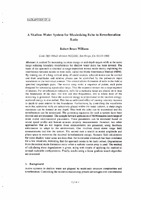| dc.contributor.author | Williams, Robert Bruce | |
| dc.date.accessioned | 2018-10-11T14:05:39Z | |
| dc.date.available | 2018-10-11T14:05:39Z | |
| dc.date.issued | 1993/08 | |
| dc.identifier | 799 | |
| dc.identifier.govdoc | CP-42/1 | |
| dc.identifier.uri | http://hdl.handle.net/20.500.12489/133 | |
| dc.description.abstract | A method for increasing incident energy on mid-depth targets while at the same range reducing boundary reverberation for shallow water ducts has been devised. The basis of the approach is couched in range dependant normal mode theory. exploiting the interference between modes to form nulls. called the Modal Interference Method (MIM). By making use of a long vertical array of sound sources. selected modes can be excited and their amplitudes and relative phases can be controlled by the pulsed-cw input waveforms to the individual sources. This control allows formation of nulls in the field at specified range/depth pairs. The source array emits a sequence of pulses. each pulse designed for optimizing a particular range. Thus the sequence sweeps out a range segment of interest. For reverberation reduction. nulls for a particular range are placed on or near the boundaries of the duct. For low and mid frequencies. this is where most of the scattering is generated. Since the scattered energy is proportional to the incident energy. scattered energy is also nulled. This has an additional effect of causing intensity maxima in depth to exist interior to the boundaries. Furthermore. by controlling the waveforms such that additional nulls are selectively placed within the water column. a sharp single maximum can be formed at one depth. Thus both the echo can be maximized and the reverberation can be minimized. The governing equations for such a system have been derived and are presented. The straight forward application of MIM requires knowledge of some modal environmental parameters. These parameters can be estimated based on sound speed profile and bottom acoustic property measurements. However. two other approaches that do not require those measurements are presented. using feedback information to adapt to the environment. One involves direct down range field measurements tied into the system. The second uses a search in modal amplitude and phase space to minimize the received (reverberation) energy. Acousticfield calculations for some shallow water areas are described. Environmental mismatch has been simulated for a few situations. indicating that the approach seems to be fairly robust. Degradations from theoretical mode formation occur when a realistic source array is used. The method of calculating these degradations is given. along with results of applying the method to several realizable configurations. Finally. results using a linear gradient search algorithm are presented. | |
| dc.format | 12 p. : ill., 15 fig. ; digital, PDF file | |
| dc.language | English | |
| dc.publisher | NATO. SACLANTCEN | |
| dc.source | In: Low frequency active sonar (SACLANTCEN Conference Proceedings CP-42), vol. 1, 1993, pp. C/13-1 - C/13-12. | |
| dc.subject | Acoustic reverberation | |
| dc.subject | Shallow water | |
| dc.subject | Reverberation suppression | |
| dc.subject | Active sonar | |
| dc.subject | Signal processing | |
| dc.title | A shallow water system for maximizing echo to reverberation ratio | |
| dc.type | Papers and Articles | |
| dc.type | Conference Proceedings (CP) | |
